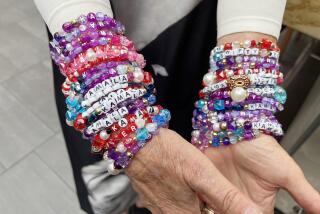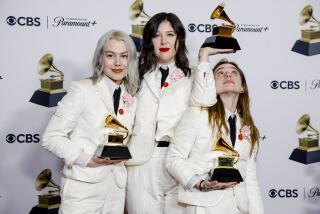Not Your Conventional Political Party : History: The voting is done with pocketbooks as collectors swarm over Nixon Library swap meet of campaign memorabilia. The vintage souvenirs range in price from less than $1 to thousands.
YORBA LINDA â People seeking a bit of American history filled their shopping bags this weekend at the Nixon Library & Birthplace.
On Saturday, a crowd of more than 1,000 political junkies, including a heavy sprinkling of history teachers, lawyers and political science students, bought and traded campaign memorabilia ranging from buttons to bumper stickers, ashtrays, books and jewelry that dated to the 1800s.
Henry Michalski of San Francisco, one of the collectors at 27 tables at the libraryâs third annual fair, said he took duplicates of only a small portion of his campaign button collection to display. âI have thousands going back to Abraham Lincoln,â he said.
Like most everyone at the fair, Michalski is a history buff who knows the issues behind the buttonsâ slogans and what impact they had at the polls. He said his interest in politics and campaign buttons dates to the 1956 Republican National Convention when, as an 11-year-old, he sneaked into the Cow Palace in San Francisco to watch Dwight D. Eisenhower get nominated for President.
Michalski said the value of the buttons has escalated dramatically since he first began collecting them.
âIn the 1960s, you could buy anything for a few dollars,â he said. âWhat you could get then for $5 now often is worth $500.â
Buttons at the fair ranged from boxes of them that sold three for $1 to rare ones costing several thousand dollars.
Neal Machander, a retired Santa Ana High School history teacher and national president of the American Political Items Collectors, said the value of campaign buttons depends primarily on their scarcity, although the popularity of the candidate being advertised also plays a role.
âThe most popular President is Theodore Rooseveltâ among collectors, he said, while cults also have developed around other Presidents, most notably John F. Kennedy and Richard Nixon.
Not only the winners attract a following.
âWilliam Jennings Bryanâs buttons are more popular than William McKinleyâs although McKinley beat himâ because of Bryanâs more colorful personality, Machander said.
Bruce Davidson, an administrator at Grossmont High School in La Mesa, said he has used his expansive political memorabilia collection to make his history lessons come alive.
He said he has turned a classroom at the school into a âkind of a political museumâ with 400 campaign bumper stickers on the ceiling.
âTen years after students leave school, they donât remember what they read but they remember what they learned from what they saw and felt,â Davidson said.
Besides history teachers, lawyers were prevalent at the fair.
âThese are our success stories,â said Chris Upton, a 50-year-old lawyer from Los Angeles, gazing at the presidential campaign buttons. Upton said she had just finished reading a biography on Warren G. Harding and was shopping for some mementos from his political era.
An hour later, she said she had discovered that the Harding button she wanted cost $2,000. âSo much for that,â she said, settling instead for a Woodrow Wilson button for which she paid $30.
Nearby, Justice Edward J. Wallin, a member of the 4th District Court of Appeal in Santa Ana, was filling a fanny pack with his finds. âIâm a [Hubert H.] Humphrey collector,â said Wallin, who was born and raised in Minnesota, the home state of the former U.S. senator and vice president under Lyndon B. Johnson.
Bob Clifford, treasurer of the Southern California chapter of the American Political Items Collectors, said that with the advent of mass media advertising, campaign committees in more recent decades have spent less on buttons in order to spend more money on television and radio spots.
Also, he said, the practice of wearing buttons to publicly display political preferences began losing appeal after the 1950s.
âToday itâs not cool,â he said. âIf you wear a campaign badge, you are a nerd.â
More to Read
Get the L.A. Times Politics newsletter
Deeply reported insights into legislation, politics and policy from Sacramento, Washington and beyond. In your inbox three times per week.
You may occasionally receive promotional content from the Los Angeles Times.










